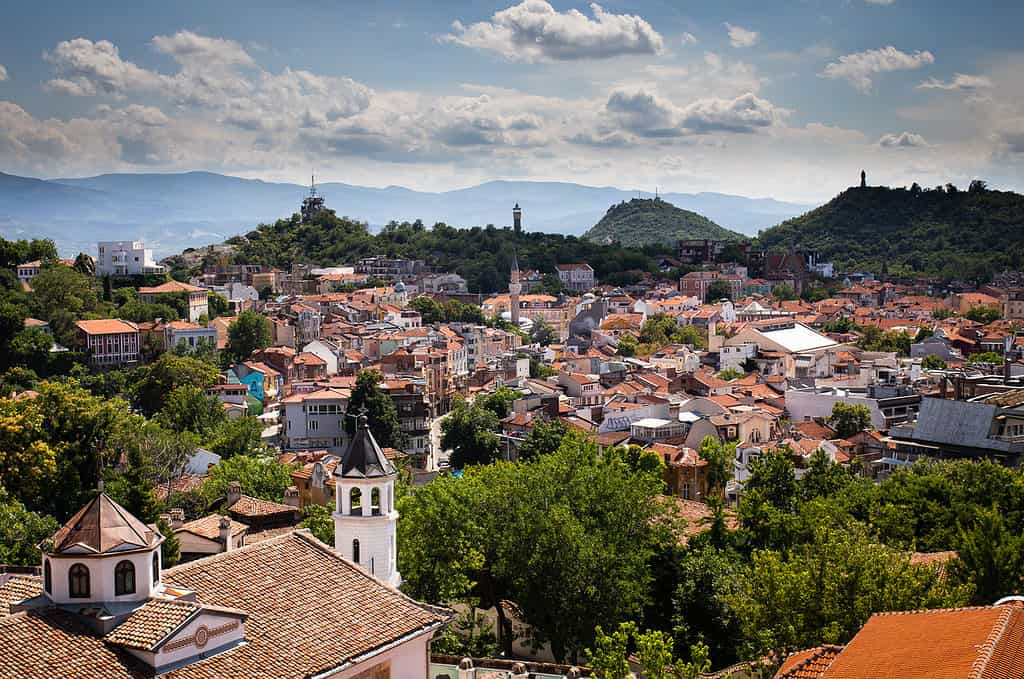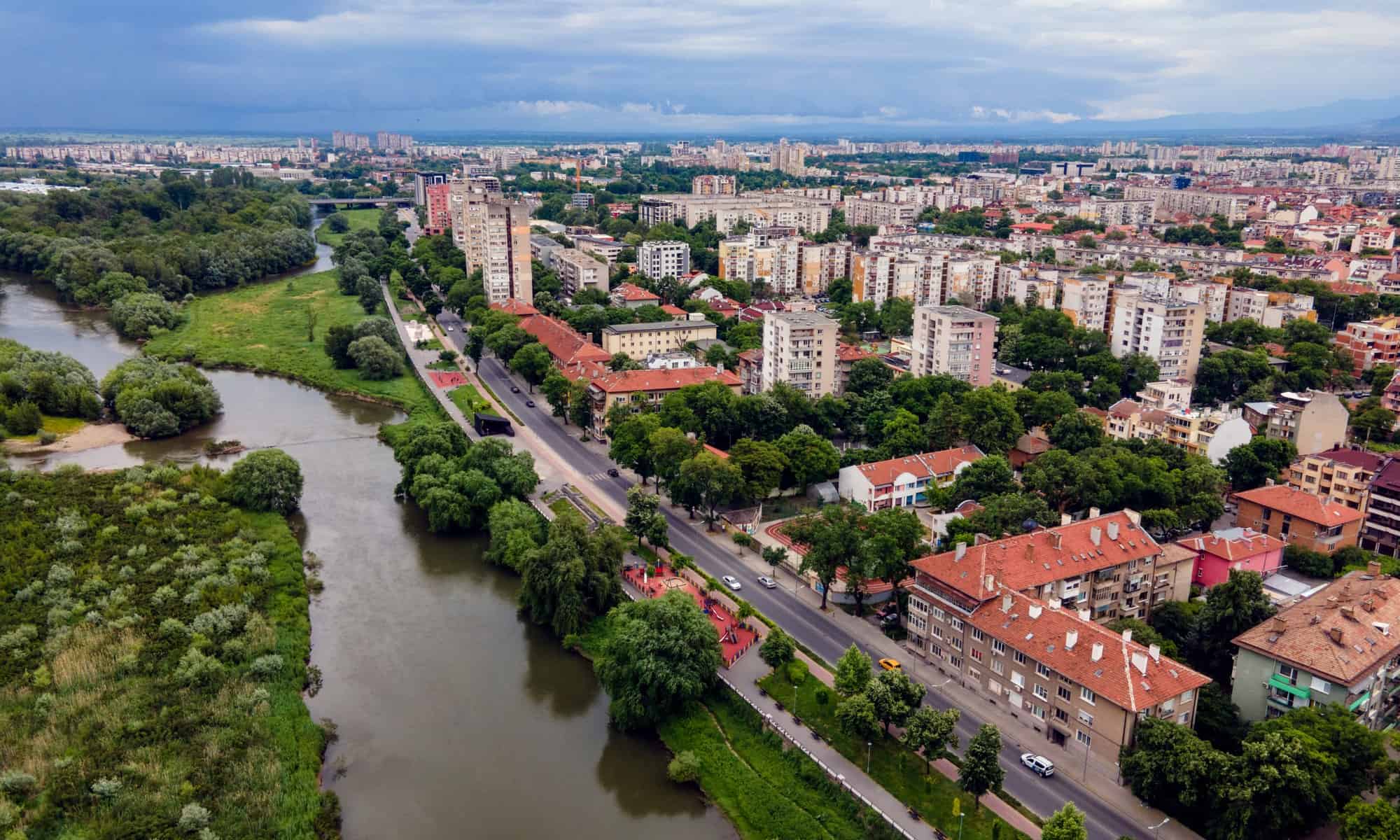Welcome to Plovdiv, the oldest continuously inhabited city in Europe! Located in Bulgaria, this ancient metropolis has a history stretching back 8,000 years. It offers visitors a unique glimpse into its culture and heritage. Plovdiv is truly an incredible place to explore, from its world-famous ruins to its vibrant nightlife. Read on for five fun facts about the oldest city in Europe to discover why a visit to Plovdiv is a must for any traveler.
Plovdiv is famous for being the second-largest city in Bulgaria. It sits in the region of Thrace, which was the location of some of the earliest European settlements. Evidence of Neolithic and Chalcolithic cultures still exists throughout the region, making Plovdiv just one of the many historical sites and cities in this area.
1. Modern Plovdiv Had Many Original Names

The city of Plovdiv has been given many names in the past.
©iStock.com/hale irwin
Plovdiv isn’t the first name given to the oldest city in Europe. First named Kendros and Emolpias by the Thracians, the name of this city changed many times throughout its history. Here’s a list of historical names of Plovdiv, though there were probably at least a few more:
- Kendros
- Eumolpias
- Philippopolis
- Pulpudeva
- Thrimonzium
- Ulpia
- Flava Julia
- Plapdiv
- Pulden
- Populdin
- Ploudin
- Filibe
Over time, Philipopolis changed hands quite a bit before becoming the modern Plovdiv of today. Here’s a list of some of the civilizations who battled, won, and lost control of this city during its dramatic history:
- Persians
- Thracians
- Macedonians
- Romans
- Byzantines
- Goths
- Huns
- Crusaders
- Ottoman Turks
The name Plovdiv started and stuck during the Ottoman Empire, though the Turks first named it Filibe. Plovdiv became an important economic center and significant trading hub during this time and for years to come.
Plovdiv is built at the foot of the seven syenite hills and has the nickname of The City in the Hills. Syenite is a type of course rock common in this area, though there are only six remaining syenite hills in modern times.
2. Plovdiv Has an Ancient Roman Stadium Big Enough for 30,000 People
One of the most impressive sights in Plovdiv is the ancient stadium of Philippopolis. Constructed around the start of the 2nd century A.D., this stadium could seat up to 30,000 people. It was initially used for various events, such as athletic games, gladiatorial battles, and chariot races.
Part of the stadium is remarkably well-preserved, giving visitors a glimpse into the grandeur of ancient Plovdiv. Its original size was about 240 meters (790 feet) long and 50 meters (164 feet) wide, though most of it deteriorated over time. Today, only about one-third of the original stadium remains intact.
Visitors of the Stadium of Philippopolis can also explore the nearby Odeon and Ancient Theatre of Philippolis. Both are additional historic sites worth visiting!
3. Plovdiv’s Well-Preserved Ancient Roman Theater Still Hosts Performances

The theater is built in a semi-circle and is the second-largest ancient theater in Bulgaria.
©iStock.com/RossHelen
The Ancient Theatre of Philippolis was built by the Romans in the 1st century A.D. and could seat up to 7,000 people. This well-preserved theater stands between two of the syenite hills and has a beautiful backdrop of the city below. Visitors can explore its 28 rows of marble seating and even catch an occasional performance!
The theater is built in a semi-circle and is the second-largest ancient theater in Bulgaria. It was used for performances, such as plays and concerts, during the Roman era and later served as a fortress in times of war. Today, this stunning structure is open to visitors looking to learn a lot more about its history.
The Ancient Theatre now hosts many outdoor events, like the Opera Open music festival and a rock festival called Sounds of the Ages.
4. The Oldest City in Europe Has the Longest Pedestrian Street
Plovdiv is also home to the longest pedestrian street in Europe, famous for its vibrant nightlife and unique shops. Called the Kapana District, this area is widely considered Plovdiv’s cultural quarter. It contains a mix of old-world charm and modern architecture, making it an ideal place to explore. And its cobblestone streets, specialty shops, galleries, and many eateries make this district a magnet for tourists and locals alike.
The Kapana district was once home to many craftsmen and artisans. Today, you can find some of the city’s most unique restaurants and bars in this part of town. From traditional Bulgarian taverns to small cafes, this area is perfect for a night out or a leisurely wander.
Kapana District has some pretty close competition for the longest pedestrian street in Europe. Some say Rue Sainte-Catherine in Bordeaux, France is the winner of this title, and they could be right. But our research puts Plovdiv’s pedestrian street at 1.8 km long and Bordeaux’s at 1.2 km long, so Plovdiv gets the medal. However, they’re both winners in our minds, and both are wonderful places to visit in Europe!
5. Plovdiv Is Known for Its Wine
Plovdiv is also an important center for wine production in Bulgaria. While the city doesn’t have a long tradition of winemaking, its terroir has become increasingly popular in recent years.
The surrounding hills are dotted with hundreds of vineyards, covering more than 40 hectares (100 acres) of land and producing some of the finest wines in the area. Plovdiv’s wine is known for its distinct flavors and aromas, with a focus on reds and whites made from local varieties.
Here’s a list of some of the famous wines from Plovdiv and the surrounding area:
- Mavrud
- Gamza
- Rubin
- Dimiat
- Melnik Red
- Kadarka
- Muscat Ottonel.
Plovdiv also hosts wine festivals every summer, including the Wine and Gourmet Festival in Old Town, organized by the Tourism Council. Wine connoisseurs from around the world come to sample the city’s best wines and food vendors for a weekend in mid-May.
Bonus Fact: Plovdiv Earned the Annual Title of European Capital of Culture in 2019
In 2019, Plovdiv became a European Capital of Culture and has been taking advantage of this prestigious honor ever since. This award from the European Union lasts for one calendar year. As part of the selection process, Plovdiv had to submit a bid that presented its cultural heritage, civic engagement, and creative industry.
The official European Capital of Culture program highlights the diversity of European cultures and promotes cultural exchange between different countries. With Plovdiv’s selection, Bulgaria is now proudly showcased as one of the continent’s most vibrant destinations. As a result, Plovdiv has become even more of a tourist hotspot in the region.
This oldest city in Europe now hosts many events celebrating this recognition, ranging from art exhibitions and concerts to festivals and workshops. And the honor brings a lot of attention to Plovdiv, with tourists flocking to the city to experience its cultural wonders first-hand.
The European Capital of Culture title of 2019 belongs to both Plovdiv, Bulgaria, and Matera, Italy.
The Oldest City in Europe Has a Rich History and Exciting Modern Attractions
Plovdiv is one of the most exciting cities in Europe, with a rich history that stretches back 8,000 years. So whether you’re interested in exploring its ancient ruins or enjoying its vibrant festivals, Plovdiv has something to offer everyone.
Want even more reasons to visit Plovdiv? Here are a few additional Plovdiv events and attractions to add to your Must See list:
- Plovdiv Night of Museums and Galleries – Free access to a long night of fun museum and art gallery hopping! This event takes place in September. Take advantage of the Ethnographic museum and its period costumes and jewelry!
- This city has beautiful historic churches and cathedrals to visit, including Chiesa SS. Constantin e Elena and Sveta Marina Church.
- Easy day trip adventures from Plovdiv include exploring the underground beauty of Cave Shezhanka, about 41 kilometers (25 miles) away from the city.
Plovdiv also offers plenty of outdoor entertainment, such as biking along the Maritsa River. Or take a walk up to Nebet Tepe Hill for breathtaking views over the city. The rich history and culture in and around this city are legendary and beloved by visitors worldwide.
5 More Oldest Cities in Europe
In addition to Plovdiv, there are many more ancient European cities to explore. Here’s a list of five more of the oldest cities in Europe with exciting historical relevance:
- Argos, Greece – Founded in 5000 BCE, Argos is famous for its Roman baths and ancient Greek sculptures.
- Nitra, Slovakia – Founded in 5000 BCE, Nitra is known for its stunning castle, many beautiful cathedrals, a great-tasting wines.
- Bratislava, Slovakia – Founded in 5000 BCE, Bratislava sits near the Danube River and has beautiful old architecture, including the Bratislava Castle.
- Varna, Bulgaria – Founded in 4600 BCE, Varna is a coastal city next to the Black Sea. It’s the sea capital of Bulgaria and home to one of the oldest gold treasures ever found.
Up Next:
Thank you for reading! Have some feedback for us? Contact the AZ Animals editorial team.








